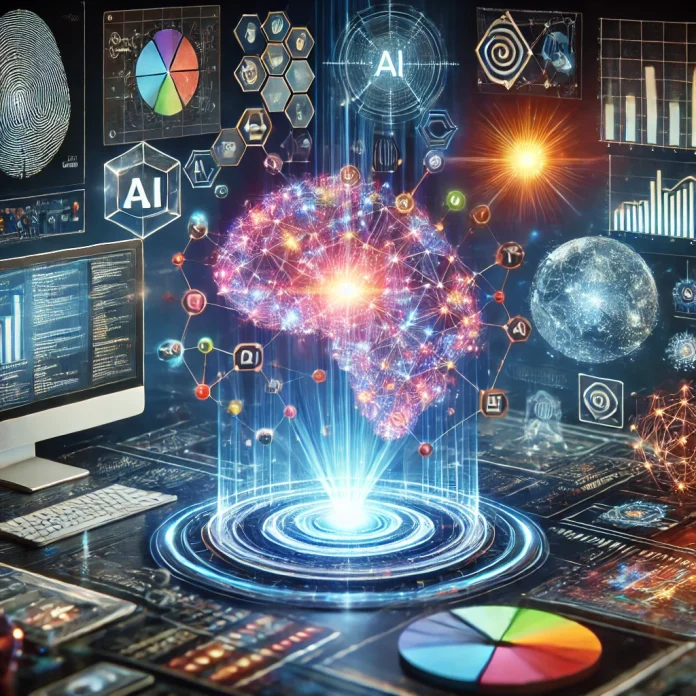Generative AI has reached a new stage of sophistication in 2024, with profound implications for industries across the globe. What began as a research-focused tool has quickly evolved into a competitive market, with businesses racing to incorporate AI into their operations. Whether in creative fields, software development, or customer service, generative AI is poised to transform the way we work, interact, and create.
A New Era for AI Products and Services
The past year has seen rapid advancements in generative AI, a technology that uses machine learning models to generate new content, ranging from text and images to music and code. Unlike traditional AI systems, which are rule-based and require explicit programming, generative AI learns patterns from vast datasets and can produce original content based on this training. This leap in capability is paving the way for a wide array of innovative applications.
A clear trend emerging in 2024 is the increasing maturity of generative AI offerings. In the past, the market was flooded with nascent tools and concepts, each offering only a glimpse of what the future might hold. However, in 2024, companies have refined these tools into powerful solutions capable of tackling real-world challenges. For instance, AI can now generate high-quality written content, design graphics, and even compose complex pieces of music, making it an invaluable asset for creatives.
The competitive landscape in generative AI is intensifying, with leading companies like OpenAI, Google, and Microsoft vying for dominance. These tech giants have invested heavily in developing cutting-edge AI models that can serve a variety of industries. OpenAI’s GPT series, for instance, has been widely adopted in applications ranging from chatbots and customer support to code generation and content creation.
As these tools become more sophisticated, we’re beginning to see AI’s potential reach into areas previously thought to be out of reach for automation. Businesses are leveraging AI to create highly personalized content at scale, automate labor-intensive tasks, and enhance decision-making processes. For example, the use of AI in marketing allows companies to craft tailored messaging for individual customers, improving conversion rates and customer satisfaction.
Multimodal AI: The Next Frontier

Another exciting development in 2024 is the rise of multimodal generative AI. While traditional AI systems often excel in one area, such as text or image recognition, multimodal AI integrates multiple forms of input and output. This means an AI model can analyze text, images, and audio, and generate responses that span these different media formats. For businesses, this opens up new possibilities for creating more engaging and interactive experiences.
Take, for instance, customer service applications. With multimodal AI, businesses can offer support via text, voice, and even video. Imagine a scenario where a customer interacts with an AI chatbot that not only responds in text but also displays visual guides or communicates via voice to provide a more personalized experience. This shift toward multimodal AI could revolutionize industries like retail, healthcare, and education, where communication is multi-faceted and highly personalized.
The Growing Demand for AI Solutions
The race for AI supremacy is not just about who can build the most advanced model, but also who can integrate these tools into existing business operations in a meaningful way. For businesses to remain competitive, there’s an increasing pressure to incorporate generative AI into their daily operations. Companies are looking for ways to streamline processes, cut costs, and improve productivity—all of which can be achieved through AI-powered automation.
Additionally, the rapid adoption of generative AI is creating a new market for specialized software and services. Companies providing cloud-based AI tools are seeing massive growth as businesses turn to platforms like Amazon Web Services (AWS) and Microsoft Azure for scalable AI solutions. These platforms offer businesses the infrastructure and tools they need to integrate AI into their operations without needing to invest heavily in building their own AI systems.
Moreover, ethical considerations are becoming a focal point. As AI becomes more ingrained in daily life, consumers and businesses alike are demanding transparency in how AI models are built and how they operate. Companies that prioritize ethical AI practices are likely to have a competitive edge, as consumers increasingly expect their tools to be not only innovative but also responsible.
The Future of Generative AI
Looking ahead, the future of generative AI seems poised for even greater advancements. With the continued growth of AI capabilities, new use cases are emerging that could fundamentally change industries. For instance, in healthcare, AI is being used to generate synthetic medical data for research purposes, while in education, AI tutors are being developed to offer personalized learning experiences.
While the technology is still evolving, the rapid pace of development in 2024 indicates that generative AI will soon become a mainstay in various sectors, impacting everything from creative industries to logistics, healthcare, and beyond. As businesses continue to explore AI’s potential, it’s clear that the technology is not just a passing trend but a long-term shift in how we approach problem-solving, innovation, and automation.
In conclusion, the rise of generative AI marks a pivotal moment in the evolution of technology. As these tools become more refined and integrated into everyday business processes, they are poised to redefine industries, enhance productivity, and open up new possibilities for the future. With a growing focus on multimodal capabilities and ethical considerations, 2024 is set to be a transformative year for AI development.



